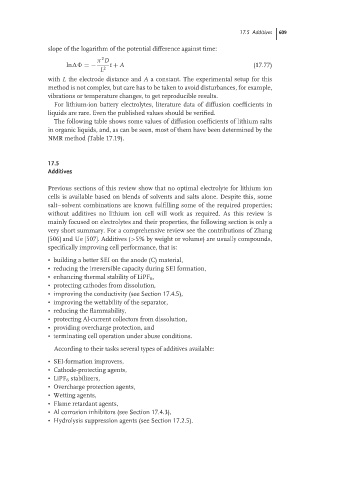Page 635 - Handbook of Battery Materials
P. 635
17.5 Additives 609
slope of the logarithm of the potential difference against time:
2
π D
ln =− t + A (17.77)
L 2
with L the electrode distance and A a constant. The experimental setup for this
method is not complex, but care has to be taken to avoid disturbances, for example,
vibrations or temperature changes, to get reproducible results.
For lithium-ion battery electrolytes, literature data of diffusion coefficients in
liquids are rare. Even the published values should be verified.
The following table shows some values of diffusion coefficients of lithium salts
in organic liquids, and, as can be seen, most of them have been determined by the
NMR method (Table 17.19).
17.5
Additives
Previous sections of this review show that no optimal electrolyte for lithium ion
cells is available based on blends of solvents and salts alone. Despite this, some
salt–solvent combinations are known fulfilling some of the required properties;
without additives no lithium ion cell will work as required. As this review is
mainly focused on electrolytes and their properties, the following section is only a
very short summary. For a comprehensive review see the contributions of Zhang
[506] and Ue [507]. Additives (>5% by weight or volume) are usually compounds,
specifically improving cell performance, that is:
• building a better SEI on the anode (C) material,
• reducing the irreversible capacity during SEI formation,
• enhancing thermal stability of LiPF 6 ,
• protecting cathodes from dissolution,
• improving the conductivity (see Section 17.4.5),
• improving the wettability of the separator,
• reducing the flammability,
• protecting Al-current collectors from dissolution,
• providing overcharge protection, and
• terminating cell operation under abuse conditions.
According to their tasks several types of additives available:
• SEI-formation improvers,
• Cathode-protecting agents,
• LiPF 6 stabilizers,
• Overcharge protection agents,
• Wetting agents,
• Flame retardant agents,
• Al corrosion inhibitors (see Section 17.4.3),
• Hydrolysis suppression agents (see Section 17.2.5).

